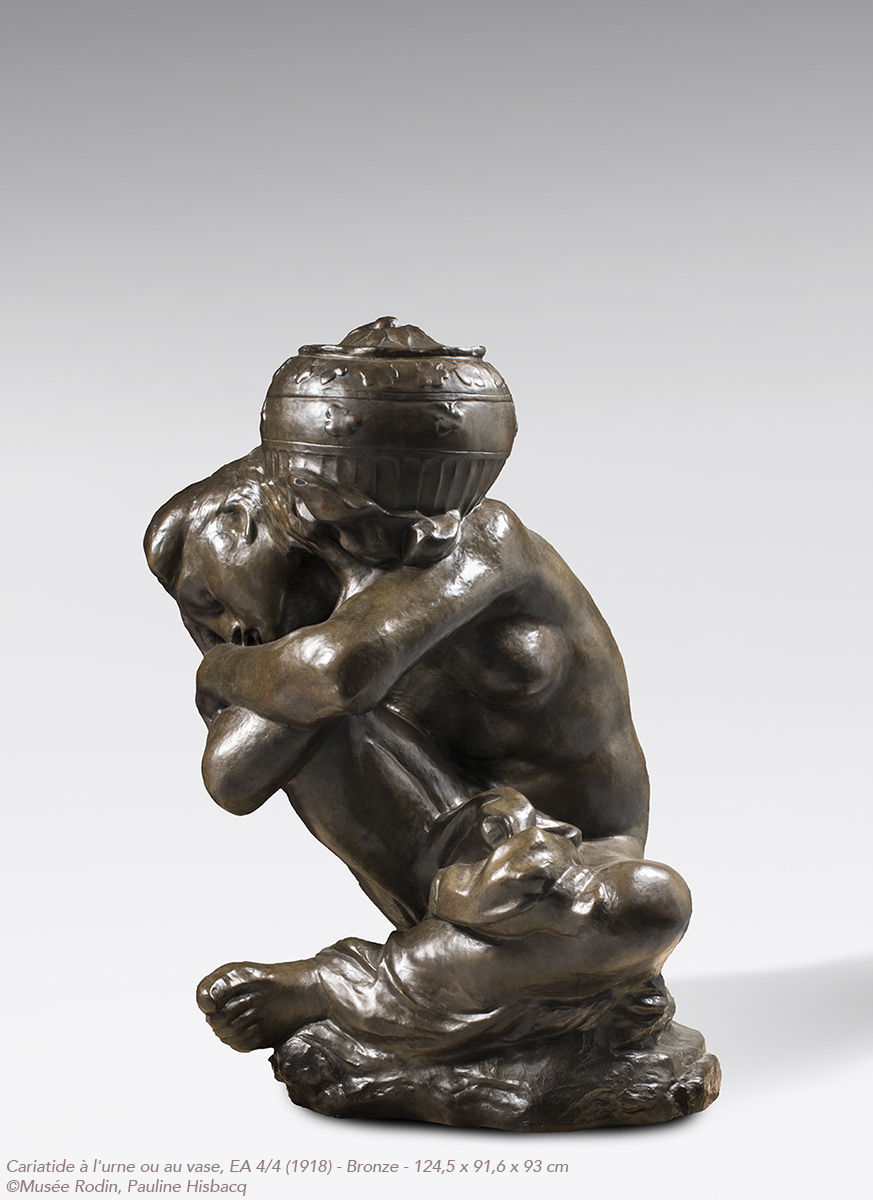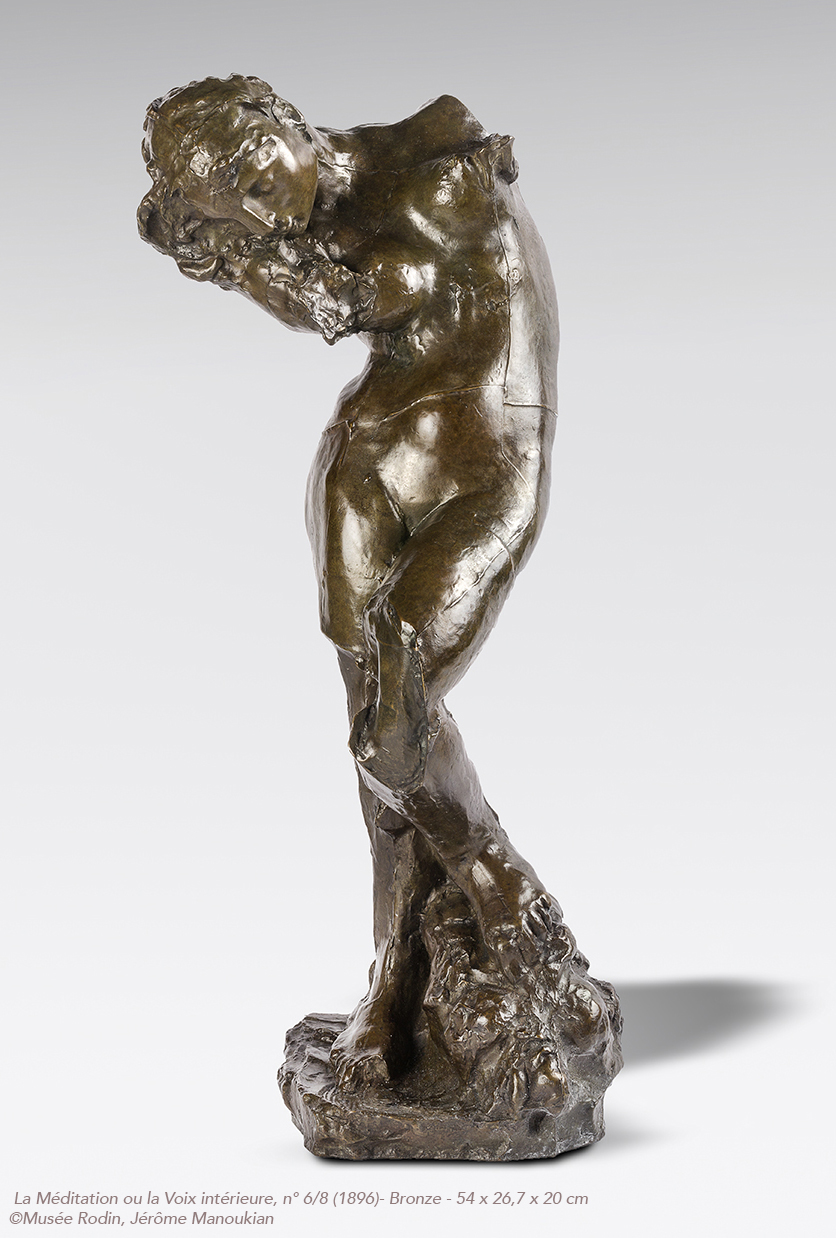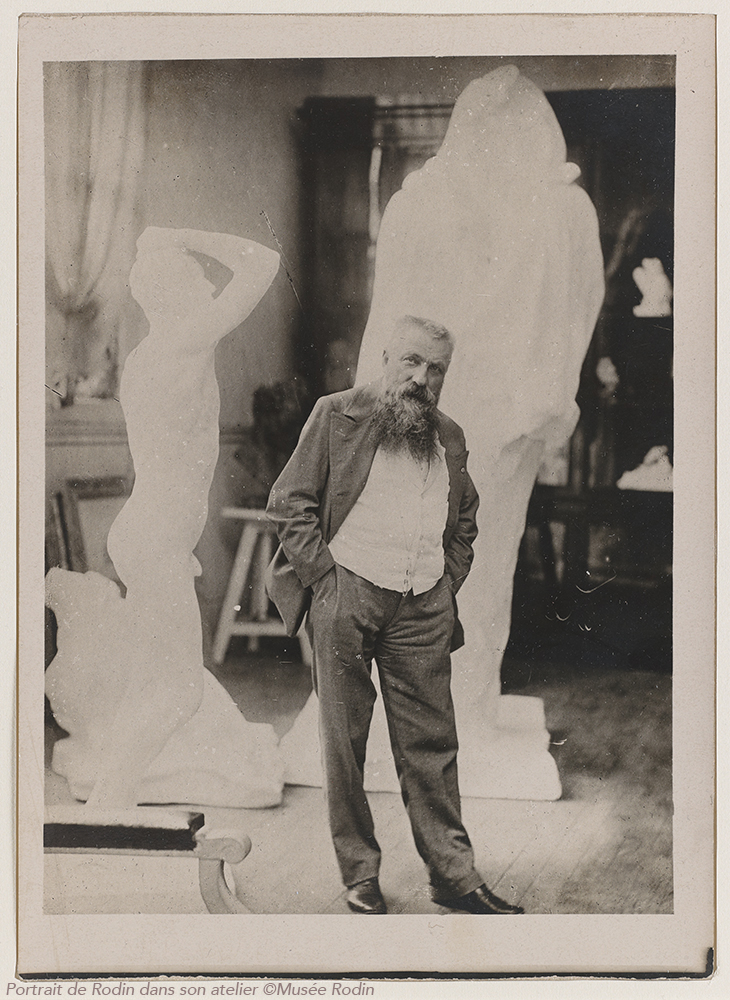ONE MONTH
ONE ARTIST
Auguste RODIN
1840 - 1917
The means is the modeling: it is by the modeling that
the flesh lives, vibrates, fights, suffers...
Auguste Rodin
TESTAMENT TO YOUNG ARTISTS
Young people who want to be Beauty Officials, perhaps you will like to find here the summary of a long experience.
Devotionally love the masters who preceded you. Bow down before Phidias and Michelangelo. Admire the divine serenity of one and the fierce anguish of the other. Admiration is a generous wine for noble spirits.
But beware of imitating your elders. While respecting tradition, know how to discern what it contains of eternally fruitful: love of Nature and sincerity. These are the two strong passions of geniuses. All have adored Nature and have never lied. Thus tradition hands you the key to escape from routine. It is the tradition itself that recommends you to question Reality continuously and forbids you to submit blindly to any master.
Let Nature be your only Goddess. Have absolute faith in her. Be certain that she is never ugly and limit your ambition to be faithful to her.
Everything is beautiful for the artist, for in every being and in everything, his penetrating gaze discovers character, that is to say, the inner truth that is revealed in form. And this truth is beauty itself. Study religiously: you cannot fail to find beauty, because you will meet the truth.
Work hard.
You statuesque people strengthen your sense of depth. It is difficult for the mind to become familiar with this notion. It is distinctly represented only from surfaces. Imagining shapes in thickness is difficult for him. Yet this is your task.
Above all, make clear the large planes of the figures you are sculpting. Vigorously accentuate the orientation that you give to each part of the body, to the head, the shoulders, the pelvis, the legs. Art requires decision. It is through the marked flight of lines that you plunge into space and take hold of the depth. When your plans have been decided, everything is found. Your statue is already alive. The details are born and then they dispose of themselves.
When you model, never think on the surface, but in relief.

Let your mind conceive any surface as the end of a volume that pushes it from behind. Think of the shapes as pointing towards you. All life emerges from a centre, then it germinates and blossoms from the inside out. In the same way, in beautiful sculpture, one always guesses a powerful inner impulse. This is the secret of ancient art.
You painters also observe reality in depth. Look, for example, at a portrait painted by Raphael. When this master depicts a figure from the front, he makes the chest flee obliquely and this is how he gives the illusion of the third dimension.
All great painters probe space. It is in the notion of thickness that their strength lies.
Remember this: there are no lines, there are only volumes. When you draw, never worry about the outline, but about the relief. It is the relief which governs the contour.
Practice relentlessly. You have to break away from your craft.
Art is only feeling. But without the science of volumes, proportions, colours, without the skill of the hand, the most vivid feeling is paralysed. What would become of the greatest poet in a foreign country whose language he didn't know? In the new generation of artists, there are many poets who, unfortunately, refuse to learn to speak. So they just stammer.
Patience! Don't count on inspiration. It doesn't exist. The only qualities of the artist are wisdom, attention, sincerity, will. Carry out your work like honest workmen.
Be true, young people. But that doesn't mean: Be flatly accurate. There's a low accuracy: that of photography and casting. Art only begins with inner truth. Let all your shapes, all your colours express feelings.
The artist who is content with trompe l'oeil and who slavishly reproduces worthless details will never be a master. If you have visited any campo santo in Italy, you will have noticed how childishly the artists who decorate the tombs try to copy embroidery, lace and hair braids in their statues. They may be exact. They are not true, since they do not address the soul.
Almost all our sculptors are reminiscent of Italian cemeteries. In the monuments in our public squares, all you can see are redingotes, tables, pedestals, chairs, machines, balloons, telegraphs. There is no inner truth, therefore no art. Dislike this thrift shop.
Be profoundly, fiercely truthful. Never hesitate to express what you feel, even when you find yourself in opposition to received ideas. Perhaps you will not be understood at first. But your isolation will be short-lived. Friends will soon come to you: for what is deeply true for one man is true for all.
Yet no grimaces, no contortions to attract the public. Simplicity, naivety!
The most beautiful subjects are in front of you: they are the ones you know best.

My very dear and great Eugène Carrière, who left us so quickly, showed genius in painting his wife and children. All he had to do was celebrate his mother's love to be sublime. Masters are those who look with their own eyes at what everyone has seen and who know how to see the beauty of what is too usual for other spirits.
Bad artists always put on other people's glasses.
The great point is to be moved, to love, to hope, to tremble, to live. To be a man before being an artist! True eloquence makes a mockery of eloquence, Pascal used to say. True art mocks art. I take here the example of Eugène Carrière. In exhibitions, most paintings are just paintings: his seemed, in the midst of the others, like windows open to life!
Welcome fair criticism. You will recognize them easily. They are the ones that will confirm you in a doubt you are besieged with. Do not allow yourself to be led astray by those that your conscience does not admit.
Do not fear unfair criticism. They will revolt your friends. It will force them to reflect upon their sympathy for you, and they will show it more resolutely when they can better discern the reasons for it.
If your talent is new, at first you will have few supporters and many enemies. Do not be discouraged. The first will triumph: for they know why they love you; the others do not know why you are obnoxious to them; the first are passionate about the truth and are constantly recruiting new adherents to it; the others show no lasting zeal for their false opinion; the first are tenacious, the others turn to all the winds. The victory of truth is certain.
Don't waste your time in worldly or political relationships. You will see many of your colleagues arrive by intrigue to honors and fortune: they are not true artists. Some of them, however, are very intelligent, and if you undertake to fight with them in their field, you will consume as much time as they do, that is to say your whole existence: you will therefore not have a minute left to be an artist. Passionately love your mission. There is nothing more beautiful than that. It is much higher than the common man thinks.
The artist sets a great example.
He loves his job: his most precious reward is the joy of doing well. At present, alas! the workers are persuaded to hate their work and sabotage it for their misfortune. The world will be happy only when all men have the souls of artists, that is, when everyone takes pleasure in their work.
Art is still a magnificent lesson in sincerity.
The true artist always expresses what he is thinking at the risk of upsetting all established prejudices.
In this way he teaches candour to his fellow men.
Imagine what wonderful progress would suddenly be made if absolute truthfulness reigned among men!
BIOGRAPHY

On November 12, 1840, René François Auguste Rodin was born in Paris. In 1854, Auguste Rodin convinced his father to enrol him at the Imperial Special School of Drawing and Mathematics where he took painting and drawing lessons from Horace Lecoq de Boisbaudran. The following year, he discovers sculpture, and spends a lot of time drawing at the Louvre Museum, the Imperial Library's Print Room and the Gobelins Manufacture.
In 1860, Rodin creates his first sculpture: a bust of his father inspired by portraits of Roman rulers during Antiquity. In 1864, he begins a collaboration with the sculptor Albert-Ernest Carrier-Belleuse whom he will follow in Belgium. The same year he met Rose Beuret who would give him a son, Auguste Beuret, two years later.
In 1870 he accompanied the Belgian sculptor Antoine-Joseph Van Rasbourgh to Brussels. Back in Paris, he is mobilized, then reformed because of myopia. The following year, he joins Carrier-Belleuse in Belgium, where he will associate with Van Rasbourgh.
In 1874, he took part in the decoration of the Palais des Académies in Brussels and painted a series of landscapes of the Soignes forest. In 1875, he went on a study trip to Italy and discovered Renaissance artists. He is particularly inspired by the work of Michelangelo.
He begins the Age of Airain which will be exhibited in 1877 in Brussels. The sculpture will then be presented in Paris where he is accused of having moulded his figure on nature. Back in France with Rose, he starts working at the Manufacture de Sèvres until December 1882.
In 1880, the French State bought the Age d'Airain and ordered a door for the future Museum of Decorative Arts: The Gates of Hell, for which he would execute the figures of Adam, Eve and the Thinker two years later. In 1883, he created the bust of Victor Hugo. The same year, he met Camille Claudel, with whom he would maintain a relationship until 1898.
Two years later, the municipality of Calais commissioned him to create the Monument to the Burghers of Calais.
In 1886, he created the Baiser. In 1888, the State ordered the marble Kiss. The following year, Auguste Rodin exhibits with Claude Monet at the Georges Petit gallery. He receives the commission for the Monument to Victor Hugo for the Pantheon.
In 1891, the Société des gens de Lettres commissioned a monument to him at Balzac.
A few years later, in 1895, he bought the Villa des Brillants in Meudon and began to build up his collection of antiques and paintings.
From 1899 onwards, Auguste Rodin took part in numerous exhibitions in France and abroad. That same year, he had his first monographic exhibition in Brussels and then in the Netherlands. In 1900, on the fringe of the Universal Exhibition, Rodin had his own exhibition in a pavilion on the Place de l'Alma in Paris. Two years later, he exhibited his works in Prague.
In 1904, The Thinker (plaster / large model) is presented for the first time at the International Society in London, then at the Paris Salon (bronze). The following year, Rainer Maria Rilke, whom he met in 1902, became his secretary.
In 1906, The Thinker is placed in front of the Pantheon. In 1908, Rodin moves to the Hôtel Biron on the advice of Rainer Maria Rilke. In 1909 the Monument to Victor Hugo is inaugurated at the Palais Royal.
In 1911, the French State orders him a bust of Puvis de Chavannes for the Pantheon. The Man Who Walks was installed in the Farnese Palace in Rome. In 1914, Auguste Rodin left for England with Rose to escape the war. He also stays in Rome for a while.
In 1916, he sold his collections to the State in three successive donations. The same year the National Assembly voted to establish the Rodin Museum at the Hotel Biron.
After marrying Rose on 29 January 1917 in Meudon, she died on 14 February. Auguste Rodin died on 17 November. Two years later, on 4 August 1919, the Rodin Museum opened its doors to the public.
DONATION AND SPECIAL POSITION OF THE RODIN MUSEUM
I give to the State all my work in plaster, marble, bronze, stone, and my drawings.
as well as the collection of antiques that I was happy to gather for
the learning and education of artists and workers.
And I ask the State to keep in the Hotel Biron which will be the Musée Rodin
all these collections, reserving my life to live in them for the rest of my life.
Auguste Rodin
Correspondence of Rodin, volume III, 1908-1912,
letter n°103 to Paul Escudier, late 1909
The artist's donation in 1916 is the founding act of the Musée Rodin. The establishment, according to Rodin's own wishes, continues to publish and sell original works in bronze, thanks in particular to the moulds and original models bequeathed by the sculptor.
The Musée Rodin is Rodin's heir and holder of the moral rights. Moral rights are perpetual, inalienable and imprescriptible (Intellectual Property Code, L 121-1). The mission of the museum is therefore to ensure respect for the work (to ensure respect for Rodin's name, his qualities as a sculptor, draughtsman and painter, the identity and integrity of his work, which must not be altered or deformed in form or spirit and in detail.
These editions are produced in strict compliance with the law (limited to 12 copies and Rodin's moral rights, and carefully checked by specialised staff).
As such, the Musée Rodin is the only national museum that is self-financed.
TO TAKE A LOOK AT AUGUSTE RODIN'S ARTWORKS, CLICK HERE